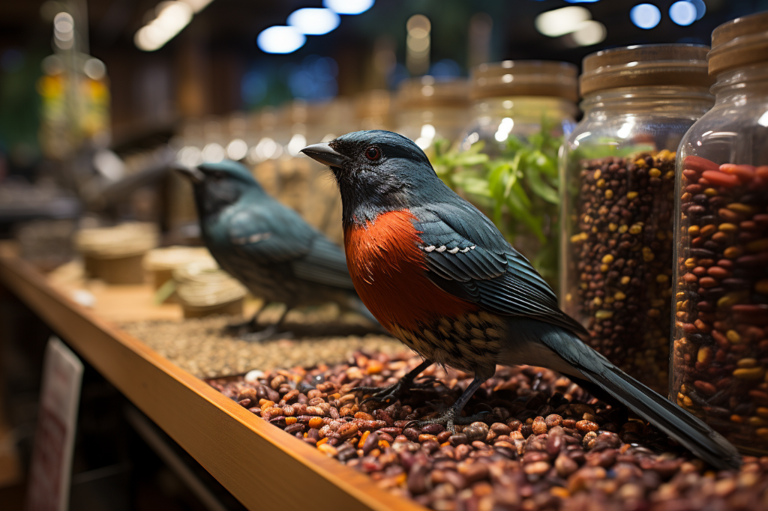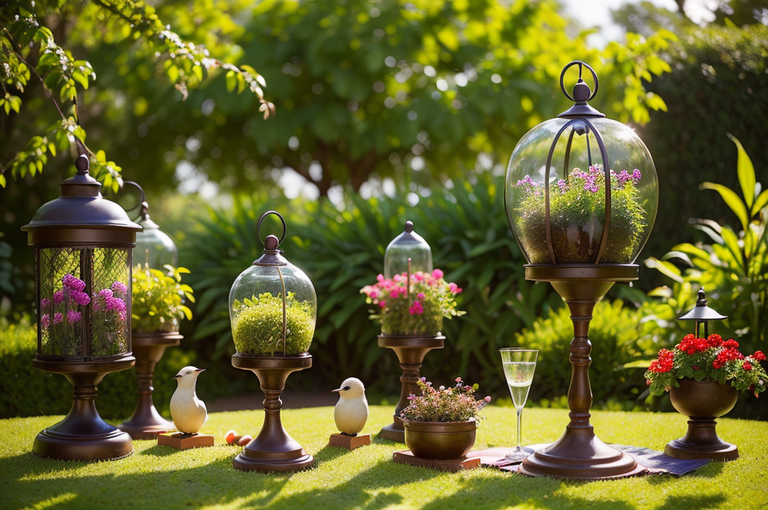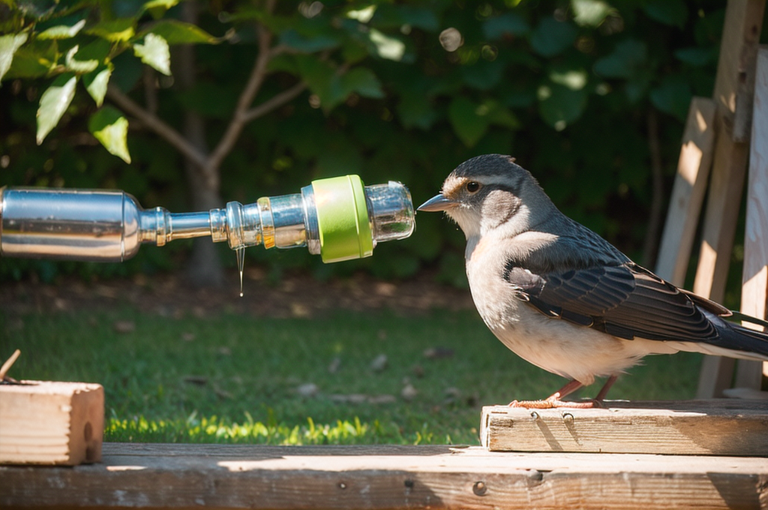Mastering the Art of Bird Feeders: Placement, Food Varieties, Cleaning Tips, and More

The article discusses optimal bird feeder placement, types of bird food, cleanliness and maintenance of feeders, protection from predators, providing water for birds, and nestbox maintenance for attracting varied bird species.
Importance of Bird Feeder Placement
I often find myself contemplating the serene tableau of my garden at dawn, coffee in hand, entranced by the diverse gathering of Ma Nature’s twittering choir. The secret to such avian diversity? Feeder placement. Yes, you read that right. It’s as much a science as asking can wild birds eat raisins. It’s a little more complex than a game of pin the tail on the donkey it’s more strategic and considerably more rewarding.
Attracting a Variety of Bird Species
Methodically scattering my feeders across the green expanse, each is positioned like solitaire gemstones in a brooch. This arrangement of feeders is master crafted to lure an array of feathered creatures. Different species have varying preferences and by taking these into account, our gardens transform into thriving, feathery landscapes.
Minimizing Threats to Birds
Safety, too, is a vital consideration in feeder placement. I consciously place the feeders to minimize dangers – like the neighboring prowling felines or the windowpane’s deceptive reflection. These silent threats can deter our winged friends, reducing their visits and threatening their survival.
Discouraging Squirrels and Other Animals
I’ve also had my tryst with squirrels and less feathery visitors. To keep these stubborn culprits at bay, feeder positioning should be as strategic as a game of chess. By placing my feeders high and away from leaping off points, I’ve found success discouraging non avian visitors, keeping the trove of seeds reserved just for my avian friends.
Feeder placement is about more than just aesthetics it’s a delicate science that can prove tremendously rewarding when mastered. Equally critical as scouting the perfect spot for that Mediterranean style birdbath, it’s this attention to detail that makes the difference between a plain backyard and a delightful bird sanctuary.

Variety in Bird Food
As an avid bird enthusiast, I would be remiss not to address the question, what to feed a wild bird? The answer? Variety is the key. 🐦🌱🍓
Role of Diverse Foods in Attracting Various Bird Species
Feeling the tug of wanderlust, I’ve spent countless mornings stationed at my window, gazing at the flurry of feathers outside. Over the years, I’ve learned that providing a mixed menu of seeds, nectar, fruits, and suet can attract a stunning array of bird species. Each delicacy, whether it’s a sunflower seed or a bit of juicy apple, promises both nutrition and delight to our feathered friends.
Inclusion of Certain Safe Household Scraps
A hasty audit of our kitchens can yield yet another assortment to share with the birds. Please, remember to tread here with caution. Not all household scraps are safe for wild birds. But, selected remnants, provided in small portions, can indeed contribute to their dietary diversity. Bits of unsalted nuts, cooked rice, oats; these could all find a second wind in the beaks of nature’s songmasters.
Seasonal Variation in Bird Food Offering
Ever the patient observer, I’ve heralded the changing seasons and with them, the fluctuation in bird sightings and their feeding habits. The chill of winter may demand hearty suet balls, while warm summers call for the sweetness of nectar. Tailoring offerings to the season not only extends a helping hand to birds but also attracts different seasonal visitors to your birdfeeder.
Dabbling in the art and science of birdwatching is a gratifying endeavor and feeding them right is our duty as stewards of nature. Understand and cater to their varied dietary needs and, in doing so, invite the enchanting spectacle of birdlife right into your backyard. 🌳🕊️

Maintenance of Bird Feeders
To maintain a thriving bird community in your backyard, one mustn’t overlook the importance of regular upkeep of our feathery friends’ sustenance source. Yes, dear reader, I’m speaking of the humble bird feeder. Let me echo those lost whispers of the wisest aviary enthusiasts: whatever you do, keep your bird feeders clean and well maintained! 🐦
Regular Cleaning: An Essential Practice
Inviting wild birds into our backyard spaces is more than tossing breadcrumbs; it requires the frequent scrubbings of the bird feeders to keep nutrients intact and discourage the unsavory growth of the harmful mold. A weekly cleaning with mild disinfectants should do the trick, ensuring that the feeder remains as enticing and beneficial to the birds as when you first placed it, full of whatever the local population likes to feed on. And speaking of what to feed wild birds, your feeding considerations must be in sync with their nutritional needs, and not just human food scraps.
The Peril of Neglecting Feeder Cleanliness
Ignoring the cleanliness of bird feeders, on the other hand, could have dire consequences. A neglected feeder easily becomes an avian illness hotspot, leading to the unfortunate transmission of diseases amongst our bird neighbors. It’s essential to remember that the care we extend to birds also extends to maintaining their health and safety.
Refeeding Guidelines After Identification of a Sick Bird
Imagine you’ve identified a sick bird at your feeder. What happens next? Do not fret or shun from the endeavor. Rather, we must act responsibly by pausing the feeding, executing a thorough cleaning of the feeder, and connecting with local wildlife services if the bird’s condition does not improve. The joy of bird feeding is not merely in watching their beautifully hued bodies dart and dive amidst backyard landscapes. It’s also about safeguarding their health, ensuring that their visits to their favorite human’s yard remain a source of delight and nutrition, not an avenue of peril. 🕊️
In maintaining feeders, we assure ourselves of the continuous pleasure of bird watching and extend our guardianship to the winged creatures that grace our backyards with their enchanting presence.

Predator Protection Measures
Spotting wild birds images against a clear blue sky can be a genuinely thrilling experience. But ensuring the safety of these feathered guests while they hang around our backyards is of paramount importance.
Role of Reducing Feeder Spillage
On many a morning, while lazily sipping my coffee, I’ve noticed from my kitchen window that minimizing feeder spillage indeed plays a crucial role in predator protection. Less food waste on the ground means fewer mice and bears lured to your yard, thereby preventing any potential wildlife conflict. It’s simple, yet surprisingly effective.
Use of Scent Deterrents
As an ornithologist and adventurer, I have learned that scent deterrents can be remarkably effective for warding off potential predators such as cats. The intricate balance of nature can be kept intact by employing these deterrents, without causing harm to these curious cats or any other creatures that might cause unintended harm to our feathered friends.
Implementation of Spice Deterrents
Spicing up things can get a little interesting as well. Strong chili or pepper sauces, I’ve found, have a strong deterrent effect against squirrels and other unwanted feeder visitors. Such unique strategies have immensely helped in preserving the peaceful co existence of diverse species in my backyard. Just a few drops can spare our tiny, chirpy guests the unwelcome attention of these mischievous creatures.
Implementing sensible measures in our everyday life can make a world of difference in keeping our avian friends safe. So, let us take these proactive steps today and ensure that we have plenty more opportunities to enjoy wild birds images adorning the sky.
Water and Nestbox Maintenance for Birds
The Lifeline of a Regular Water Source
I often find myself contemplating, over my morning cup of tea, just how essential a consistent source of clean water is for attracting our feathered friends. One cannot simply ask, what to feed a wild bird? and dismiss the role of water in their survival. Indeed, it is this refreshing liquid provision that birds flock to—making it a fundamental requirement for those who wish to witness the enchanting array of wild birds’ images in their backyard.
The Crucial Sip during Extreme Weather
However, as the sun bids a harsh goodbye, or winter lends its chilling stroke, the availability of clean water morphs into more than a mere attraction—it becomes a lifeline. What to feed wild birds takes on a deeper context during these periods of extreme weather. The wild birds, coated in layers of nature’s hues, count on these water sources for crucial hydration.
The Art of Nestbox Maintenance
Now, on the subject of nestboxes—nestled amidst nature, each a home to a flurry of feathers—they too need the same attentive care we give to our bird feeders and birdbaths. It might sound unusual to our ears, but it’s a truth that resonates throughout the avian world: nestboxes should be cleaned annually in the autumn.
Removing old nests and annihilating the remaining parasites is like refreshing the canvas for the next generation. Perhaps this is our own subtle contribution to this intricate, beautiful ballet of nature, a small yet significant role in preserving what we all hold dear: the magic and mystery of birds.
So, can wild birds eat raisins? Sure they can. But providing them with a consistent source of clean water and a well maintained nestbox are equally, if not more, critical to supporting the mesmerizing display of our avian neighbors.


